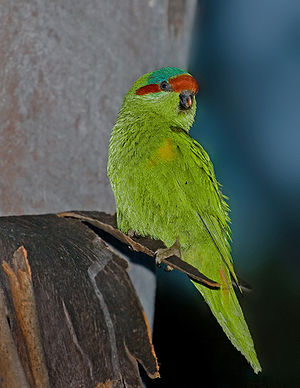Musk Loris
| Musk Loris | ||||||||||
|---|---|---|---|---|---|---|---|---|---|---|

|
||||||||||
| Systematics | ||||||||||
|
||||||||||
| Scientific name | ||||||||||
| Glossopsitta | ||||||||||
| Bonaparte , 1854 |
The glossopsitta ( Glossopsitta ) are a genus of parrots. The genus includes three closely related species that are all found exclusively in southern Australia. As with many parrots, taxonomic degradation is changing. The ornithologist Joseph M. Forshaw , who specializes in Australian parrots, believes it is possible that species of the ornamental lory will be classified as the musk loris in the future.
features
Musk Loris are small species of the Loris , a group of parrots that are traditionally classified as a subfamily of the real parrots . As with all Loris, their beak is pushed in on the side and the tongue has elongated papillae at its tip. Musk Loris have predominantly green plumage. The blue- parted lori has the most colorful plumage , while in the musk lory, areas of color deviating from green are limited to the head plumage. Common to all species is the short, wedge-shaped tail. The beak is small and delicate and mostly black. Only in the musk lory the tip of the beak is colored coral red. All species have a noticeable beak notch in the upper beak. While the musk lory has a weak sexual dimorphism , the blue-parted lori and dwarf musk lory cannot distinguish the sexes based on their external characteristics.
The Musk Lorikeet is the largest of the Musk Lorikeets with a body length of 22 centimeters. The other two species reach a body length of 15 to 16 centimeters. The flight of all kinds is straight and fast. Shrill, metallic-sounding contact calls can be heard during the flight. During the foraging for food, on the other hand, a low chatter can be heard incessantly.
Distribution area
The distribution of the musk loris is limited to Australia. The dwarf mosquito is found in eastern and south-eastern Australia from north Queensland to the south-east of South Australia . It may also be common in Tasmania . The range of the Musk Lorikeet strongly overlaps with that of the Dwarf Musk Lorikeet. However, it extends further west and extends as far as Kangaroo Island . It is definitely found in Tasmania and inhabits the eastern half of this island off the south coast. Musk Lorikeets have been introduced in the Perth area.
The blue-parted lory has a disjoint distribution area. It occurs both in the southeast of Australia and in the southwest. In contrast, it is absent in southern central Australia and Tasmania in between. In the south-west of Australia, the blue-headed lory is the only species of lori.
Reproduction
As is characteristic of most of the parrots, Musk Lorikeets are also cave breeders. They prefer to build their nests in trees that are not far from water holes. Usually two to four eggs are laid. The female breeds alone. The incubation period is 23 days. The young birds are completely feathered between the 40th and 45th day of life and then leave the nesting cavity.
species
- Musk lorikeet ( Glossopsitta concinna )
- Dwarf Musk Lorikeet ( Glossopsitta pusilla )
- Blue- parted Lorikeet ( Glossopsitta porphyreocephala )
supporting documents
Individual evidence
literature
- Joseph M. Forshaw , illustrated by William T. Cooper: Australian Parrots. 1st German-language edition. Volume 1: Cockatoos and Lories. Arndt-Verlag, Bretten 2003, ISBN 978-3-9808245-1-4 .
